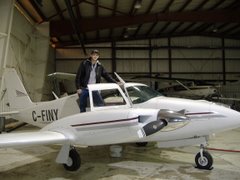In order for the magnetic sensors on the wings and tail to accurately measure the earth, any magnetic components on the aircraft, especially near the sensors must be demagnetized. Hardware like nuts and bolts can be tricky because they have a tendency to magnetize themselves over time, so we have to go hunting for them by running a compass past and seeing if it swings towards its. If we find a nut or bolt or screw that is magnetic, we'll replace it if we can, or run it through a degausser, which is a machine that electrically scrambles the polarity of the particles in the hardware and demagnetizes it. The degausser is far from perfect - sometimes it works, other times it ends up magnetizing the hardware even more. Its tedious and time consuming work.
Hopefully soon we'll be on our way. A couple days ago I planned out our route to Newfoundland. I had a total of 5 VNCs (aviation maps) all laid out on the floor and lined up. On the map itself our route measures over 10 ft long - a total of about 900 nautical miles. That's a long trip! It will be fun to fly all the way out east.
In the mean time we're stuck checking out of our hotel every morning with the hope of being on our way, only to have to take the walk of shame in the evening and check back in. The hotel customer service manager always gets a laugh out of this. It's not an uncommon scenario for us actually, it happens fairly often as there are always some sort of delays in trying to get off to a new job. When we check out the hotel staff are never quite sure whether to wish us well on our way, or to say "see you soon". Such is the reality when you combine the somewhat unrefined technology field of airborne geophysics with the equally unreliable industry of general aviation. It's impossible to make hard and fast plans when weather, broken airplanes, or finicky survey equipment are a part of the equation.
Just a day in the life...




No comments:
Post a Comment